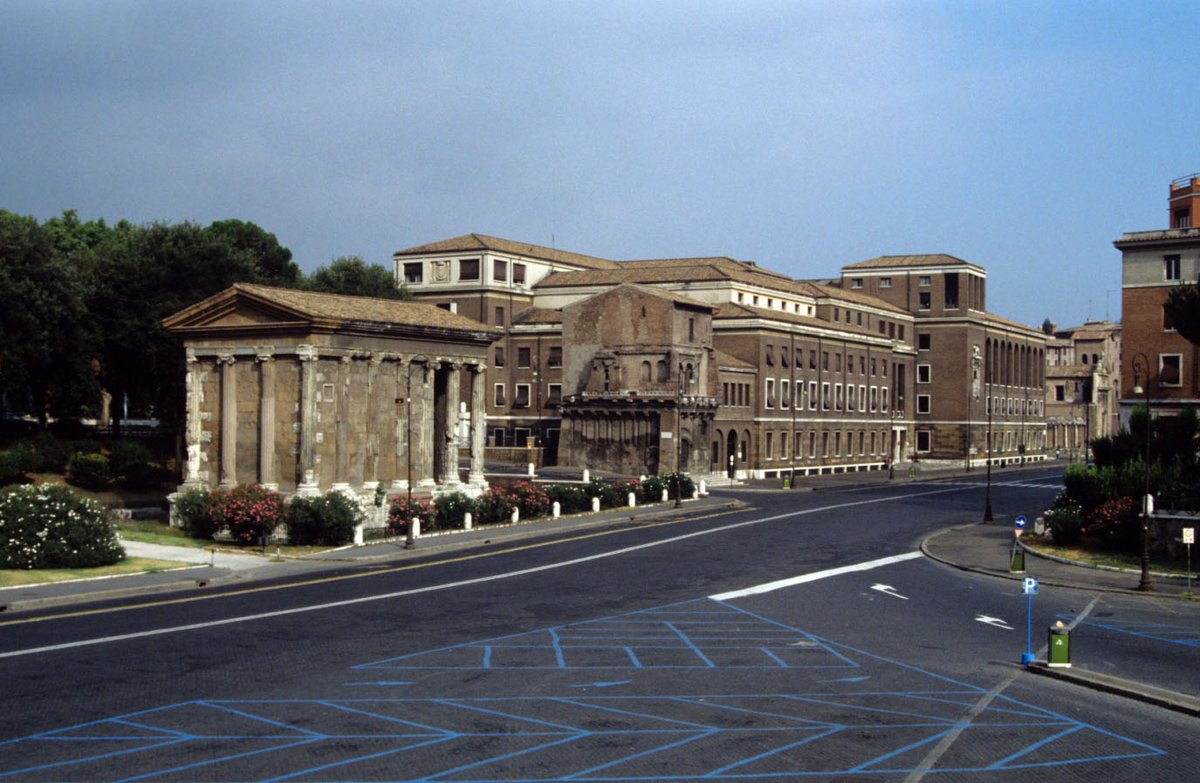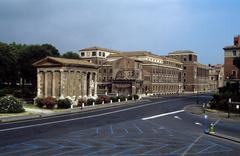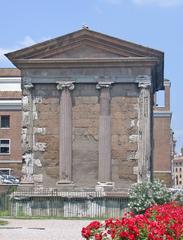
Temple of Portunus: Visiting Hours, Tickets, and Historical Significance in Rome
Date: 14/06/2025
Introduction
The Temple of Portunus stands as one of Rome’s most captivating and best-preserved ancient monuments, located in the historic Forum Boarium near the Tiber River. This iconic temple, dating back to the Republican era, provides visitors with a rare opportunity to experience Rome’s religious, commercial, and architectural heritage firsthand. Dedicated to Portunus, the Roman god of keys, doors, livestock, and especially harbors and river crossings, the temple symbolizes Rome’s deep-rooted connection to trade and safe passage along the Tiber—a vital artery for the city’s prosperity (Wikipedia; SmartHistory).
This guide explores the temple’s origins, architectural features, historical and cultural significance, and provides practical information on visiting hours, tickets, accessibility, and nearby attractions to ensure a rewarding visit.
Historical Background
Origins and Dedication
The Temple of Portunus dates to the 3rd or 4th century BCE, with major reconstruction between 120 and 80 BCE. Dedicated to Portunus, the god of keys and harbors, its prominent position next to the Forum Boarium and the Portus Tiberinus highlights its role as a protector of commerce and river crossings (Wikipedia; Madain Project).
Portunus originally safeguarded gates and granaries, but as Rome’s reliance on river trade grew, his association extended to harbors. The annual Portunalia festival on August 17 featured rituals such as burning old keys, symbolizing protection and renewal (SmartHistory).
Urban Significance and Preservation
Strategically placed at the bustling Forum Boarium—the city’s cattle market and commercial hub—the temple overlooked the Tiber and was adjacent to the Pons Aemilius, Rome’s oldest stone bridge (Wikipedia; Italy4.me). Its preservation is largely due to its conversion into the Christian church of Santa Maria Egiziaca in the 9th century CE, a change that protected it from destruction and allowed for later restoration to its classical form (SmartHistory; Madain Project).
Architectural Features
Design and Layout
The Temple of Portunus is a textbook example of late Republican Roman temple architecture, skillfully blending Italic and Hellenistic influences. It is a pseudoperipteral temple: free-standing Ionic columns support the deep front portico, while engaged half-columns line the sides and rear (SmartHistory; Britannica). This approach, distinct from the Greek peripteral style, became a hallmark of Roman temple design.
- Podium: The temple stands on a high podium, accessible only from the front.
- Columns: Four free-standing Ionic columns at the front; sides and rear have engaged columns.
- Materials: Built from local tufa and travertine, originally covered with stucco to imitate marble (Madain Project).
- Cella: The small inner chamber is typical of Roman temples, with a single frontal staircase providing access.
Decorative Elements
The Ionic capitals are distinctly Roman, with volutes set at 45-degree angles at the corners. The entablature features a frieze of alternating triglyphs and metopes, blending Doric elements with the Ionic order. The original terracotta-tiled roof and painted or sculpted pediment decorations have largely been lost over time, but the structure’s proportions and details have influenced Western architecture for centuries (ArchDaily).
Cultural and Historical Significance
The Temple of Portunus encapsulates the spirit of Republican Rome—its religious devotion, commercial vigor, and architectural innovation. Its survival through conversion into a church and later restoration demonstrates the adaptability and reverence for heritage that characterizes Rome’s approach to its monuments (SmartHistory).
The temple’s influence extends beyond antiquity; it inspired Renaissance architects such as Andrea Palladio and informed neoclassical designs throughout Europe, including the Temple of Harmony in England (Madain Project; ArchDaily).
The Role of Portunus in Roman Life
Portunus was a key figure in Roman religion, representing the protection of gateways, harbors, and trade. His festival, Portunalia, was marked with rituals and offerings for the city’s prosperity and safe passage on the river (smarthistory.org). The temple’s prominent position in the Forum Boarium made it a focal point for both religious practice and commercial activity, illustrating the interconnectedness of spirituality and daily life in ancient Rome (thebrainchamber.com; myromepass.com).
Visiting the Temple of Portunus
Location and Getting There
- Address: Piazza della Bocca della Verità, 00186 Rome, Italy
- Nearest Metro: Circo Massimo (Line B), approximately a 10-minute walk
- Nearby Landmarks: Temple of Hercules Victor, Bocca della Verità, Santa Maria in Cosmedin
Visiting Hours
- Exterior Viewing: Accessible at all times
- Interior Access: Limited to special events, heritage days, or guided tours. Always check the official heritage website for current opening hours and interior access updates.
Tickets
- Exterior: Free to view at any time
- Interior: May require a ticket as part of a guided tour or special event. Prices vary; check official sources for current details.
Accessibility
- The raised podium and stairs may present challenges for visitors with mobility impairments. The surrounding area is generally flat, but the temple itself is not fully wheelchair accessible.
Best Times to Visit
- Early mornings and late afternoons offer the best light for photography and fewer crowds.
- Spring and autumn provide pleasant weather for exploring the Forum Boarium and nearby sites (Voyage Tips; Rome Actually).
Nearby Attractions
- Temple of Hercules Victor: A nearby circular marble temple, often mistaken for Greek architecture.
- Bocca della Verità: The “Mouth of Truth” is a popular photo spot.
- Santa Maria in Cosmedin: A medieval church known for its beautiful architecture.
- Forum Boarium: The ancient cattle market area with rich archaeological remains.
Visitor Tips
- Photography: Allowed from the exterior. For interior photography, abide by posted rules during special access.
- Facilities: No restrooms or cafes on-site; amenities are available nearby.
- Respect: Do not climb or touch the structure.
Guided Tours and Events
Guided tours with expert insights are available through local operators and may provide rare access to the temple’s interior. Special events and heritage days occasionally offer free admission or extended access (Wanted in Rome).
Visuals and Interactive Media
High-quality images and interactive maps are available online, providing virtual tours and aiding with trip planning. Alt-tagged images such as “Temple of Portunus Rome exterior view” can enhance accessibility and SEO.
Frequently Asked Questions (FAQ)
Q: What are the Temple of Portunus opening hours?
A: The exterior is always accessible. Interior access is limited; check the official heritage website for updates.
Q: Do I need tickets to visit?
A: Viewing the exterior is free. Interior visits may require tickets as part of a guided tour or event.
Q: Is the site accessible for people with disabilities?
A: The podium and steps limit wheelchair access. The surrounding area is generally accessible.
Q: Are guided tours available?
A: Yes, especially during special events or through local tour operators.
Q: Can I take photographs?
A: Yes, from the exterior. Interior photography may have restrictions.
Summary and Travel Tips
The Temple of Portunus is an extraordinary emblem of Rome’s ancient religious, commercial, and architectural legacy. Its preservation through adaptive reuse and restoration allows modern visitors to connect with Rome’s layered past. For the best experience:
- Visit early or late in the day for good light and fewer crowds
- Combine your visit with nearby attractions
- Check current visiting hours and ticket options before your trip
- Join a guided tour for deeper historical insights
- Use the Audiala app for expert-curated tours and updates
Call to Action
Plan your visit to the Temple of Portunus today to immerse yourself in one of Rome’s most remarkable historical sites. For the latest updates on opening hours, events, and ticket availability, download the Audiala app and explore our related guides. Follow us on social media for more inspiration and tips on exploring Rome’s ancient wonders.
References
- Temple of Portunus, Wikipedia
- Temple of Portunus, SmartHistory
- Temple of Portunus, Britannica
- Temple of Portunus, Madain Project
- Temple of Portunus, Rome.info
- Temple of Portunus, Italy4.me
- Temple of Portunus, ArchDaily
- Temple of Portunus, Rome Actually



















































































































































































































































